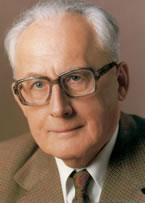Dr.-Ing. Dr.-Ing. E.h.
Rudolf Hell
Born: 19 December 1901, Eggmühl (Bavaria)
Died: 11 March 2002, Kiel
"I`ve never done anything just to earn money. For me, the important things are progress and practical applications."
Hell's scanning tube provided the basis for television recording and, for the first time, text and images were transmitted electronically over long distances by his Hell recorder.
Radio direction finding and photo telegraphy
From 1919, Hell studied electrical engineering at Munich Technical University. From 1923 to 1929 he was assistant to Prof. Dieckmann, with whom he applied for a patent for a "photoelectric scanning tube for television" on which today's television recording technology is based.
In 1927, Hell wrote his doctoral thesis on an investigation in the field of radio direction finding in aeronautics, which was far ahead of its time. This was in principle a means of navigation in zero visibility conditions (blind flight).
In the year 1929, at the age of 28, he founded his own company in Berlin which initially produced radio direction finders, Morse code devices and scanning tubes. In the same year Hell filed a patent application for a "device for electrically transmitting written characters" the so-called Hell recorder, a precursor to the fax machine. It opened a new road in telecommunications. For the first time it was possible to transmit text and images electronically over long distances.
Hell recorder
The transmitter has a typewriter keyboard. Each character is broken down into dots in a matrix of seven rows and seven columns. The individual matrix dots are transmitted column by column as a sequence of electrical impulses.
The receiver operates like a phototelegraph: Each electrical impulse causes an electromagnet to press a paper tape against an ink-coated rotating spindle. The letters are reproduced "pixel by pixel" on the paper tape.
The beginning of digital typesetting
Hell's company was destroyed during the war. In 1947, he started a company for telecommunication equipment and electronic reproduction, the Dr. Ing. Rudolf Hell KG, based in Kiel. In the following years, Hell developed the klischograph, an electromechanical device for engraving printing plates, which speeded up image printing, and the chromagraph, a scanner to create colour separations. In 1965, Hell presented the "Hellcom digiset system", an electronic typesetter. For the first time, an electronic storage unit was used for digital typesetting. Three-dimensional letters became immaterial signs and, within a few years, hot metal typesetting had passed into history.
Patent search
To find out more about Rudolf Hell's patents, go to DEPATISnet

© Heidelberger Druckmaschinen AG
Patent document DE-540849
"Vorrichtung zur elektrischen Übertragung von Schriftzeichen"
(PDF - 103 KB)
Barényi . Binnig . Bölkow . Bruch . Dethloff . Fischer . Hell . Lindenmeier . Oberth . v.Ohain . Peter . Quadbeck-Seeger . Ruska . Sauer . Wankel . Winnacker . Zuse
Copyright © Deutsches Patent- und Markenamt 2004
